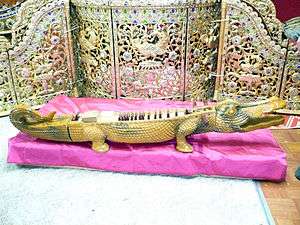Mi gyaung

The mi gyaung (Burmese: မိကျောင်း [mḭ dʑáʊɴ]) or kyam (Mon: ကျာံ, /cam/; pronounced "chyam") is a crocodile-shaped fretted, plucked zither with three strings that is used as a traditional instrument in Burma. It is associated with the Mon people.
The instrument's body is made of wood that is carved out on the underside like a dugout canoe. It has approximately 13 raised wooden frets that are diatonically rather than equidistantly or chromatically spaced. It has a carved crocodile's head and tail, as well as four legs. Its strings are tuned (from low to high) FCF. The lowest string is made of brass and the two higher strings are made from nylon. It is plucked with a short rod-shaped plectrum that tapers to a point, made of horn or hardwood. Unlike the Thai jakhe, the plectrum is not tied onto the right index finger, but instead simply held in the hand. Tremolo technique is often used. The instrument has a buzzing sound because the strings are raised just off the flat bridge by a sliver of bamboo or other thin material such as plastic.
It is similar to the Thai jakhe and the Cambodian krapeu (takhe). However, while the mi gyaung has realistic zoological features, its Thai and Cambodian relatives' animal forms are much more abstract.[1]
References
- ↑ Terry E. Miller (2008). Thailand. The Garland Handbook of Southeast Asian Music. Routledge. p. 130.
External links
Listening
- Kyam (mi gyaung) audio samples (track 6)